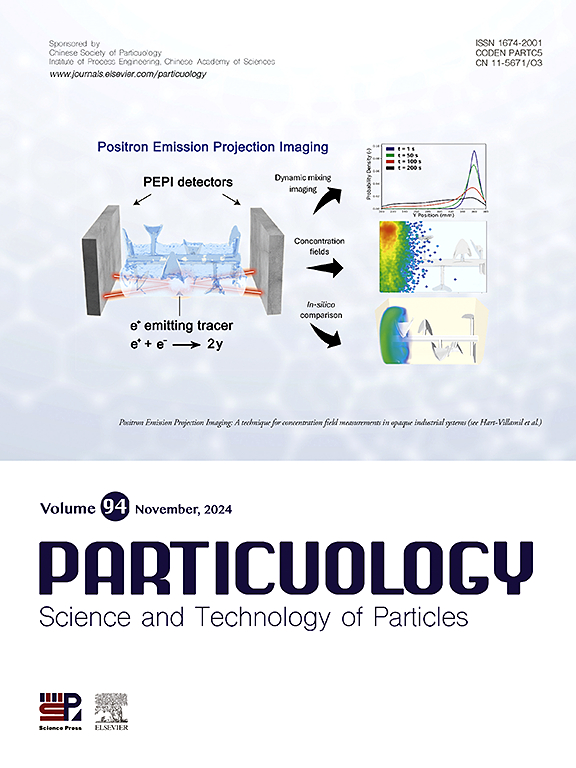From shape to behavior: A synthesis of non-spherical particle dynamics in air
IF 4.1
2区 材料科学
Q2 ENGINEERING, CHEMICAL
引用次数: 0
Abstract
Particles suspended in air are often non-spherical shapes, giving rise to shape-dependent complex dynamical processes. Suspended non-spherical particles are associated with a wide array of engineering and scientific scenarios, embodying both their microscopic and macroscopic dynamical behaviors. A comprehensive understanding of the dynamical behaviors of non-spherical particles in air hinges on the accurate identification and description of particle shape, the development of shape-specific models for the forces and torques acting on these particles, and the subsequent micro- and macroscopic phenomena that emerge as a result. This review surveys the latest advancements in the field of non-spherical particles, spanning from shape identification to the characterization of their dynamical properties. An emphasis is placed on establishing a connection between the micro- and macroscopic dynamical behaviors of non-spherical particles. The shape-induced features encompass periodic rotation and preferential orientation, which result in an oscillating migration path and lead to distinctive macroscopic characteristics. The macroscopic features of non-spherical particles are elucidated based on the preceding analysis of forces, torques, and particle-flow interactions. The future perspectives are also discussed in this review.

从形状到行为:空气中非球形粒子动力学的综合
悬浮在空气中的粒子往往是非球形的,这就产生了依赖于形状的复杂动力学过程。悬浮的非球形粒子与广泛的工程和科学场景有关,体现了它们的微观和宏观动力学行为。全面理解空气中非球形颗粒的动力学行为取决于对颗粒形状的准确识别和描述,对作用在这些颗粒上的力和扭矩的形状特定模型的发展,以及随后出现的微观和宏观现象。本文综述了非球形粒子领域的最新进展,从形状识别到其动力学特性的表征。重点是建立非球形粒子的微观和宏观动力学行为之间的联系。形状诱导特征包括周期性旋转和优先取向,这导致了一个振荡的迁移路径,并导致了独特的宏观特征。通过对力、力矩和粒子流相互作用的分析,阐明了非球形颗粒的宏观特征。本文还对未来的研究前景进行了展望。
本文章由计算机程序翻译,如有差异,请以英文原文为准。
求助全文
约1分钟内获得全文
求助全文
来源期刊

Particuology
工程技术-材料科学:综合
CiteScore
6.70
自引率
2.90%
发文量
1730
审稿时长
32 days
期刊介绍:
The word ‘particuology’ was coined to parallel the discipline for the science and technology of particles.
Particuology is an interdisciplinary journal that publishes frontier research articles and critical reviews on the discovery, formulation and engineering of particulate materials, processes and systems. It especially welcomes contributions utilising advanced theoretical, modelling and measurement methods to enable the discovery and creation of new particulate materials, and the manufacturing of functional particulate-based products, such as sensors.
Papers are handled by Thematic Editors who oversee contributions from specific subject fields. These fields are classified into: Particle Synthesis and Modification; Particle Characterization and Measurement; Granular Systems and Bulk Solids Technology; Fluidization and Particle-Fluid Systems; Aerosols; and Applications of Particle Technology.
Key topics concerning the creation and processing of particulates include:
-Modelling and simulation of particle formation, collective behaviour of particles and systems for particle production over a broad spectrum of length scales
-Mining of experimental data for particle synthesis and surface properties to facilitate the creation of new materials and processes
-Particle design and preparation including controlled response and sensing functionalities in formation, delivery systems and biological systems, etc.
-Experimental and computational methods for visualization and analysis of particulate system.
These topics are broadly relevant to the production of materials, pharmaceuticals and food, and to the conversion of energy resources to fuels and protection of the environment.
 求助内容:
求助内容: 应助结果提醒方式:
应助结果提醒方式:


